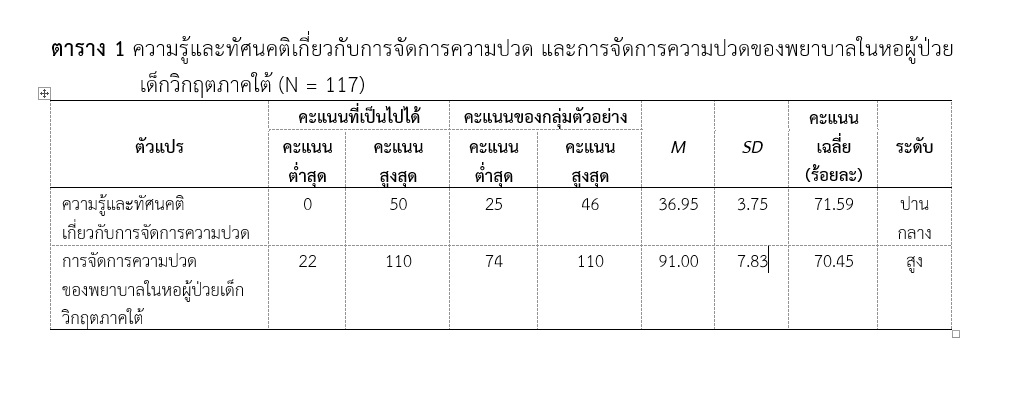ความสัมพันธ์ระหว่างความรู้และทัศนคติ กับการจัดการความปวดของพยาบาล ในหอผู้ป่วยเด็กวิกฤตภาคใต้
คำสำคัญ:
ความรู้และทัศนคติ, การจัดการความปวด, ผู้ป่วยเด็กวิกฤตบทคัดย่อ
การวิจัยเชิงความสัมพันธ์นี้เพื่อศึกษาความสัมพันธ์ระหว่างความรู้และทัศนคติ กับการจัดการความปวดของพยาบาลในหอผู้ป่วยเด็กวิกฤตภาคใต้ กลุ่มตัวอย่างเป็นพยาบาลวิชาชีพที่ปฏิบัติงานในหอผู้ป่วยเด็กวิกฤตโรงพยาบาลสังกัดกระทรวงสาธารณสุขในภาคใต้ จำนวน 88 ราย เก็บรวบรวมข้อมูลโดยใช้แบบสอบถามข้อมูลทั่วไป แบบสอบถามความรู้และทัศนคติ กับการจัดการความปวดของพยาบาลในหอผู้ป่วยเด็กวิกฤต ค่าความเที่ยงแบบสอบถามความรู้ ดยใช้วิธีคูเดอร์ริชาร์ดสัน (KR-20) ได้เท่ากับ .81 และทัศนคติเกี่ยวกับการจัดการความปวด โดยคำนวณหาค่าสัมประสิทธิ์แอลฟาของครอนบาคและแบบสอบถามการจัดการความปวดของพยาบาลในหอผู้ป่วยเด็กวิกฤต โดยการคำนวณหาค่าสัมประสิทธิ์แอลฟาของครอนบาค ได้เท่ากับ .79 หาความสัมพันธ์โดยใช้สถิติสัมประสิทธ์สหสัมพันธ์เพียร์สัน ผลการวิจัยพบว่า
1. คะแนนเฉลี่ยความรู้และทัศนคติเกี่ยวกับการจัดการความปวดของพยาบาล อยู่ในระดับปานกลาง (M=36.95, SD=3.75)
2. คะแนนเฉลี่ยการจัดการความปวดของพยาบาลในหอผู้ป่วยเด็กวิกฤตภาคใต้ อยู่ในระดับสูง (M=91.00, SD=7.83)
3. ความรู้และทัศนคติไม่มีความสัมพันธ์กับการจัดการความปวดของพยาบาลในหอผู้ป่วยเด็กวิกฤตภาคใต้ อย่างมีนัยสำคัญทางสถิติ (r = .058; p = .59)
ควรจัดอบรมเพื่อเพิ่มพูนความรู้ให้กับพยาบาลที่ปฏิบัติงานในหอผู้ป่วยเด็กวิกฤตภาคใต้ โดยเฉพาะความรู้เกี่ยวกับการประเมินความปวดและการบรรเทาความปวดโดยวิธีการใช้ยาและไม่ใช้ยาในผู้ป่วยเด็ก
เอกสารอ้างอิง
Chen, Y. Y., Chi, N. H., & Lai, Y.H. (2011). The Chinese Behavior Pain Scale for Critically Ill Patients: Translation and Psychometric Testing. Intermational Journal of Nursing Studies, 48, 438-448.
Chollada, T., Panuwat, P., & Chomnad, W. (2016). Multicultural Nursing: Competencies Necessary for Future Thai Nurses. Research Journal Health Sciences, 10(1), 8-15.
Czarnecki, M. L., Simon, K., Thompson, J. J., Armus, C. L., Hanson, T. C, Berg, K. A., et al. (2011). Barriers to Pediatric Pain Management: A Nursing Perspective. Pain Management Nurse, 12(3), 54-62.
Derond, M. E. J., Campen, B. M., & Klievink, R. M. A. (2000). A Pain Monitoring Program for Nurses: Effects on Nurses, Pain Knowledge and Attitude. Journal of Pain and Symptom Management, 19(6), 457-465.
Fowler, L., & Marmo, S. (2010). Pain Assessment Tool in the Critically III Post Open Heart Surgery Patient Population. The American Society of Pain Management Nursing, 11(3), 134-140.
Hossain, S. (2010). Nurses’ Knowledge and Attitudes, and Pain Management Practice of Post-Operative Children in Bangladesh. Master of Nursing Science Prince of Songkla University, Songkla.
Jantaveemuang, W., & Thongmeekhwan, T. (2016). Nursing Students and Spiritual Health. The Southern College Network Journal of Nursing and Public Health, 3(3), 208-219. (in Thai)
Johansson, M., & Eva, K., (2009). The COMFORT Behavioral Scale and the Modified FLACC Scale in Paediatric Intensive Care. Nursing in Critical Care, 14(3), 122–130.
Jonphajong, P., Ratchanee, U., & Wongchan, P. (2003). Research Report of Knowledge and Attitude of Nurses about Pain and Pain Management. Alumni Association the Thai Red Cross College of Nursing.
Kannika, R., Phaibun, S., & Suchart, S. (2014). Satisfaction in Practice of Nurses from Professional Nursing Production Projects to Resolve in Provincial Areas Southern. Journal of the Ministry of Public Health, 24(1), 15-20.
Katakorn, P., Autchareeya, P., & Renu, P. (2018). Nurses’ Knowledge, Attitude, and Nursing Practices for Pain Management for Postoperative Children. Ramathibodi Nursing Journal, 24(1), 37-50.
Launiala, A. (2009). How Much Can a KAP Survey Tell Us about People’s Knowledge, Attitudes and Practices? Some Observations from Medical Anthropology Research on Malaria inPregnancy in Malawi. Anthropology Matters Journal, 11, 1-13.
Mathew, P. J. (2011). Knowledge Attitude and Practice of Pediatric Critical Care Nurses Towards Pain: Survey in a Developing Country Setting. Journal of Postgraduate Medicine, 57(3), 196-200.
Monitto, C. L., & Kost-Byerly, S. (2011). The Optimal Dose of Prophylactic Intravenous Naloxone in Ameliorating Opioidinduced Side Effects in Children Receiving Intravenous Patient-Controlled Analgesia Morphine for Moderate to Severe Pain: a Dose Finding Study. Anesth Analg, 113(4), 34-42.
Narayan, M. C. (2010). Culture’s Effects on Pain Assessment and Management. Journal Am Nurse, 110(4), 38-47.
Petovello, K. (2012). Pediatric Procedural Pain Management a Review. International Journal of Child, 3(4), 10-29.
Phanarat, R., Wimolrat, S, Malinee, W., Fangam, C., Sutanee, S., Sasiwimol, C., et al. (2016). Suspension Quality Assessment Pain Chronic Pain Patients in Srinagarind Hospital. Journal of Srinakarin, 31(2), 151-158.
Polit, D. F., & Beck, C. T. (2008). Nursing Research: Generating and Assessing Evidence for Nursing Practice. (8th ed.). New York: Lippincott Williams & Wilkins.
Srisuda, N., Rungnapa, K., & Orphan, B. (2014). Knowledge and Attitude about Assessment and Pain Management of Professional Nurses Who Have Just Graduated. Journal of Phrapokklao Nursing College, 25(2), 65-72.
Suprana, B. (2010). Knowledge and Attitudes of Nurse and their Practices Regardind Post-Operative Children in Bangladesh. Master of Nursing Science Prince of Songkla University, Songkla.
Thai Association for the Study of Pain. (2018). Guidelines for the Development of Pain Management Acute in Children. Bangkok: Noppachai Printing.
Twycross A. (2010). Managing Pain in Children: Where to from Here?. Journal Clinical Nursing, 19, (15-16).
Vincent, C. V. H. (2010). Nurses’ Knowledge, Attitudes, and Practices Regarding Children’s Pain. Journal of Maternal and Child Nursing, 30, 177-183.
Vincent, C. V. H., & Denyes, M. J. (2004). Relieving Children’s Pain: Nurses’ Abilities and Analgesic Administration Practices. Journal of Pediatric Nursing, 19, 40-50.
Wantanee, W. (2018). Nursing Pain Management in Pediatric Have Surgery and are Restricted to Communication with Endotracheal Tubes. Bangkok: Sahamit Phatthanakan.
Warangkhana, A. (2013). Effectiveness of the Use of Clinical Practice Guidelines for Pain Management in Critically ill Patient Surgery Chiang Rai Hospital. Graduate School, Mae Fah Luang University, Chiang Rai. (in Thai).
Wilai, T. (2012). Operational Handbook for Assessment and Pain Management in Critical Pediatric. Nursing Service Department Songkhla Nakarin Hospital. Reproduce.

ดาวน์โหลด
เผยแพร่แล้ว
ฉบับ
ประเภทบทความ
สัญญาอนุญาต
1. บทความหรือข้อคิดเห็นใด ๆ ที่ปรากฏในวารสารเครือข่าย วิทยาลัยพยาบาลและการสาธารณสุขภาคใต้ ที่เป็นวรรณกรรมของผู้เขียน บรรณาธิการหรือเครือข่ายวิทยาลัยพยาบาลและวิทยาลัยการสาธารณสุขภาคใต้ ไม่จำเป็นต้องเห็นด้วย
2. บทความที่ได้รับการตีพิมพ์ถือเป็นลิขสิทธิ์ของ วารสารเครือข่ายวิทยาลัยพยาบาลและการสาธารณสุขภาคใต้







